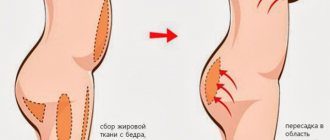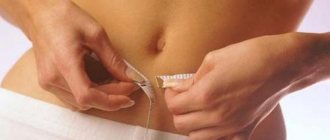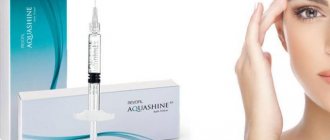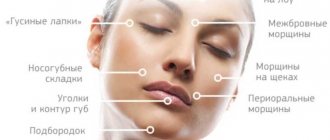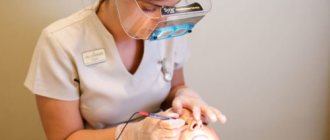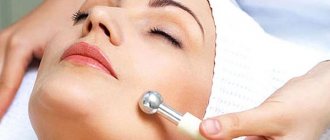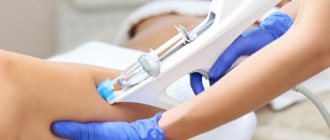Scars after tummy tuck heal under unfavorable conditions. This occurs due to the tightening of abdominal tissues, the presence of drainage and contraction of the abdominal wall muscles. To reduce the likelihood of complications to a minimum, surgeons use special suture material, as well as special suturing techniques. After the operation, antibiotics are prescribed and dressings are performed.
The number of scars varies depending on the plastic surgery technique; the appearance depends on the volume of intervention, the speed of recovery and the stage of healing.
Dependence of the shape of the scar on the type of abdominoplasty
| Classical | Vertical | Lateral |
|
|
|
| Extended | Circular | Mini |
|
|
|
Local complications
- Seroma is an accumulation of fluid in the area of a sutured wound, resulting from tissue damage and blood plasma leaking through the wall of small vessels. One of the most common complications of abdominoplasty. Prevention - wearing compression garments to properly distribute the load on the operated area.
- Hematoma is an accumulation of blood of different volumes that develops due to injury to blood vessels. For minor bruises, applying cold is enough. Large ones are opened and removed. To avoid such consequences of abdominoplasty, it is necessary to carefully stop bleeding during surgery.
- Infection - develops due to violations of asepsis rules before, during or after the procedure. Inflammation develops in the wound, which can develop into purulent inflammation when it sharply worsens the patient’s condition.
- Necrosis of the wound edges is the result of a violation of their blood supply due to damage to large vessels feeding the skin flap, strong tension of the wound edges, the presence of additional scars in the incision area and untreated seromas or hematomas.
- Loss of sensitivity occurs in almost all patients due to the intersection of nerve fibers. It goes away on its own within a few months.
- A keloid scar develops when there is insufficient blood supply to the edges of the wound. This is how nearby tissues slowly die and are replaced by scar tissue.
The listed complications of abdominal abdominoplasty are sometimes scary, but they occur extremely rarely, especially with a doctor who has performed a large number of operations. The more experienced the specialist, the fewer undesirable consequences occur during abdominoplasty. Following all the recommendations will help you quickly recover and return to your normal lifestyle without trouble.
Caring for sutures after surgery
For speedy rehabilitation, it is necessary to follow all doctor’s prescriptions. The first day the wound is under an aseptic dressing. It is recommended to adhere to bed rest for 2 weeks. To relieve tension, a special compression corset is worn for 1.5–2 months.
Water treatments are prohibited. Physical activity should be avoided for the first couple of months. You should sleep with your knees bent on your side. Scars after abdominoplasty are treated with keratolytic, anti-inflammatory ointments and silicone-based gels. It is better to avoid exposure to ultraviolet radiation or apply sunscreen. For speedy healing, massage and physiotherapeutic procedures are recommended: ozone therapy, magnetic therapy, phonophoresis.
If after 12 months the patient is not satisfied with the defect, the issue of taking additional measures is decided. Use:
- Surgical removal of excess scar tissue;
- Fractional laser bleaching;
- Chemical peeling;
- Applying a tattoo to the operated area.
Conclusion: do not be afraid of scars after abdominoplasty; if you follow the doctor’s instructions, they will be barely noticeable. The main thing is the result.
Common complications of abdominoplasty
- Pulmonary edema - occurs during abdominoplasty in the case of increased pressure in the abdominal cavity due to too much suturing of the diastasis (divergence) of the muscles. The main prevention here is training with a bandage for 2 weeks before the procedure.
- PA thromboembolism and hypostatic pneumonia are the result of reduced physical activity of the patient before and after surgery. Physical inactivity causes stagnation of blood in the veins, especially the legs, which provokes the development of thrombosis. Part of the blood clot can break off and enter the pulmonary artery, blocking the lumen. For prevention, compression stockings are used, which evenly compress the superficial veins of the legs and improve blood flow.
Causes of swelling after abdominoplasty
Abdominoplasty is a large-scale surgical intervention in the body in the abdominal area. This is a rather sensitive area on the human body. Any operations in this part are associated with a violation of the integrity of the integument and blood vessels, the entire system. Abdominoplasty involves removing excess skin and fatty tissue and suturing the abdominal muscles. It is impossible to avoid damage to blood vessels and lymphatic channels. Therefore, swelling after abdominoplasty is a natural phenomenon.
As a rule, they last a couple of months and go away quite slowly. In some cases, swelling may continue to persist for almost six months. Therefore, it is necessary to prepare yourself for the fact that you will have to endure and follow all the recommendations of the surgeon in order to avoid side effects.
All of the above reasons are planned. However, it happens that swelling appears in other places on the body. This may appear due to certain reasons. Disorders of blood and lymph circulation may be the following:
- The entire intimate area swells. This is also considered normal. Swelling occurs in this part due to the fact that there are quite loose tissues under the skin in this area. They attract liquid and hold it.
- Swelling can occur in the forearms due to constant IV drips. Constant administration of drugs causes thrombophlebitis, which disappears after discontinuation of the drugs.
- The lower extremities swell due to weak blood vessels, the presence or predisposition to varicose veins. The excess fluid should go away in a couple of weeks, but if this does not happen, you should consult a doctor.
But the following cases of edema after abdominoplasty are not the norm and indicate serious complications. They require attention and urgent medical attention, as there may be a danger to health and even life. Urgent treatment is required if:
- The abdomen enlarges, the swollen tissues become hard to the touch. You can feel the flowing liquid underneath them. In this case, compaction and swelling after abdominoplasty indicate the development of seroma, that is, a pathological accumulation of lymph. If it is not removed in time, then suppuration and even blood poisoning will begin.
a) Hematoma and b) seroma after abdominoplasty
- Infectious inflammation is manifested by increased temperature, pain, hyperemia of the skin, rapid heart rate and swelling. To avoid complications, doctors prescribe a course of antibiotics.
- If the functioning of the kidneys or heart is impaired, the swelling spreads throughout the body. This is a very serious side effect that can be life-threatening. It needs to be identified as early as possible in order to have time to take the necessary measures.
Compression garments after abdominoplasty
An important element of the recovery period is compression garments after abdominoplasty. It usually consists of a wide bandage that encircles the body in the abdominal area. Such underwear provides the necessary compression, accelerates healing and prevents swelling. Sometimes it is put on a person immediately after abdominoplasty, while he is still under general anesthesia. This allows you to protect the sutures and swelling after abdominoplasty from excessive mechanical impact.
It usually makes sense to purchase at least two sets of support clothes, which will make it easier to ensure they are washed on time. Some types of such laundry need to air dry, but this happens quite slowly, so it is logical to have a spare set. In most cases, compression garments are worn for at least 3-4 months after abdominoplasty; the rehabilitation period for this plastic surgery is very long.
Compression garments come in a variety of sizes. Putting it on may seem a little tricky at first, but practice solves this problem. It is usually easier to put it on while standing. Compression garments should be completely pressed onto the body and it is important to avoid any wrinkles or folds. Usually during the day it is necessary to adjust the position of the underwear on the body 1-2 times, as it gets a little confused during wearing. Compression garments after abdominoplasty are actively discussed in the corresponding forum section of our website.
How to ease the recovery period after abdominoplasty
Immediately after abdominoplasty, the abdomen is usually swollen and a throbbing sensation may be present in the operated area. The doctor prescribes painkillers to the patient, which must be taken if severe pain occurs. It is important not to delay taking painkillers until the pain becomes severe. Taking analgesics in advance can reduce their overall consumption. You should not endure pain, as painful sensations worsen your well-being and slow down recovery.
The pain usually goes away within a few days, as does the swelling. There may be some minor bruising, but this too will disappear in a few days. It is important to understand this so as not to become depressed and needlessly upset. The formation of hematomas and swelling is a completely normal consequence of surgical interventions, including abdominoplasty. How many days the swelling will subside and the hematomas will disappear depends on careful adherence to the doctor’s recommendations.
Upon discharge from the hospital, the attending physician provides the patient with detailed written instructions. The plastic surgeon provides his patient with a list of medications to be taken and detailed instructions regarding behavior, hygiene, wearing compression garments and lifestyle in the coming weeks and months after abdominoplasty. If you experience any alarming symptoms or adverse signs, such as fever or bleeding from the incision, you should notify your doctor immediately.
- special diet throughout rehabilitation prescribed by the surgeon
- sharp limitation of physical activity in the first days after abdominoplasty
- significant reduction in physical activity and weight lifting in the first months after surgery
- regular performance of special sets of exercises prescribed by a plastic surgeon
- quitting smoking throughout the entire rehabilitation period, as nicotine interferes with recovery processes
- abstaining from sunbathing on the beach and in the solarium during the many-month recovery period, until permission is received from the attending physician
- avoiding saunas, hot baths and contrast showers for an extended period until a doctor's permission is obtained
Lifestyle during the rehabilitation period
If you are taking oral contraceptives, be aware that some antibiotics may interact with them in undesirable ways. Therefore, in addition to oral contraceptives, additional methods of birth control should be used. Of course, in the first weeks after abdominoplasty, most patients simply abstain from sexual activity due to discomfort. Before resuming sexual activity, you should consult with your doctor to make sure that such actions are safe for the body.
Your healthcare provider will often recommend using extra pillows under your head and shoulders for the first 2 weeks to keep your upper body elevated. In the first days after surgery, the patient must lie down a lot. In an upright position, the pain intensifies and it is better to lie down or at least sit. It is important not to overload your body and nervous system in the first time after surgery; you need to get plenty of rest and sleep, as this ensures accelerated recovery after abdominoplasty.
In the first weeks after abdominoplasty, it is important to measure your temperature regularly. An elevated temperature usually indicates an infection or inflammatory process. The first time after surgery, the patient is usually prescribed antibiotics, which must be taken in strict accordance with the doctor's instructions. Even if a person feels fine, one should not arbitrarily reduce the dosage of antibiotics or stop taking them, as this is fraught with the development of infection.
Abdominoplasty is a large-scale surgical intervention on the body in the abdominal area. Any operations in this part are associated with a violation of the integrity of the integument and blood vessels, the entire system. Abdominoplasty involves removing excess skin and fatty tissue and suturing the abdominal muscles. Damage to blood vessels and lymphatic channels cannot be avoided
, which leads to swelling.
During abdominoplasty, the doctor tightens the skin and cuts off the excess part along with the fat layer. This is often accompanied by tightening and suturing of weak abdominal muscles. Inflammation and swelling occur, which is a natural protective reaction.
It is aimed at restoring the integrity of the integument.
The body begins to secrete special substances that increase the permeability of blood vessels, blood and lymphatic capillaries. Their contents begin to flow into the soft tissues. This is necessary to transport immunoglobulins and other substances to the damaged areas that destroy damaged cells and trigger recovery and regeneration. Swelling is an essential part of the healing process.
Types of abdominoplasty
Another reason is that blood and lymph flow into the incision site, but difficulties arise with their outflow. The circulation of blood and lymph will be difficult throughout the formation of the scar.
And this usually takes almost a year. But with the normal course of the process, external signs should disappear within a few months.
It happens that swelling appears in other places on the body. Disorders of blood and lymph circulation may be the following:
- The entire intimate area swells. In this area under the skin there are quite loose tissues. They attract liquid and hold it.
- Swelling in the forearms due to constant IV drips. Constant administration of drugs causes thrombophlebitis, which disappears after discontinuation of the drugs.
- The lower extremities swell due to weak blood vessels, the presence or predisposition to varicose veins. The excess fluid should go away in a couple of weeks.
Swelling that requires seeing a doctor:
- The abdomen enlarges, the swollen tissues become hard to the touch. You can feel the flowing liquid underneath them. This may be the development of seroma - a pathological accumulation of lymph. If it is not removed in time, then suppuration and even blood poisoning will begin.
- Infectious inflammation is manifested by increased temperature, pain, hyperemia of the skin, rapid heart rate and swelling. A course of antibiotics is needed.
- If the functioning of the kidneys or heart is impaired, the swelling spreads throughout the body. This is a very serious side effect that can be life-threatening.
Postoperative drains are installed.
Swelling should increase during the first days.
after abdominoplasty, and then go into decline.
The situation becomes much better after a couple of months, but everything goes away completely only at least six months later.
How to speed up healing:
- Get enough rest and sleep
. In the first days, you only need to lie in the correct position - horizontally with your legs slightly higher than your stomach. Every two hours you will have to get up and slowly walk. This prevents deep vein thrombosis. But you cannot sit, as blood and lymph flow to the incision and increase swelling. - Proper diet
. After the operation, you should not get carried away with drinking, even plain water; you should not eat salty, fatty, sweet or starchy foods. During rehabilitation, you should forget about smoking and alcoholic beverages. - Compression underwear
. Immediately after abdominoplasty surgery, the patient is given a specially selected bandage, which must be worn around the clock for the first few days, then for a couple of months only during the day. It stimulates blood and lymph circulation, which significantly accelerates the reduction of swelling.
- Compliance with restrictions
- Apply creams and gels to dissolve
and improve blood flow approximately ten days after removal of the sutures. Usually heparin ointment, Troxevasin, Troxerutin, Lyoton or Traumeel, and others are prescribed. Preparations are also used for external scar healing.
Physiotherapeutic procedures after abdominoplasty:
- LPG massage of the problem area
. The procedure is carried out on a device with special rollers that rotate and grip the skin. Rollers and vacuum stimulate tissue circulation.
LPG abdominal massage
- Lymphatic drainage massage for swelling.
Performed manually. The specialist forces the fluid to move to other places, thereby freeing the abdominal tissue and relieving swelling. - Wraps for swelling
. They can be carried out both in the salon and at home. Wraps are made with clay, honey, oils, algae and mud. The components reduce swelling after surgery. Important: you can only do it cold. The advantage of the salon procedure is that the composition is selected taking into account the age and condition of the skin.
Read more in our article about swelling after abdominoplasty.
Read in this article
Ways to reduce congestion
- Immediately after surgeryDrainage tubes are installed through the incision to remove “excess fluid” from the cavities. The patient is put on compression garments, which stimulate blood and lymph circulation and prevent stagnation. Sitting is strictly contraindicated. You need to lie on your back with the leg end raised, which helps normalize circulation. From the first day the doctor prescribes a diet. You should avoid foods rich in salt (smoked meats, canned food), consume fried and flour foods in moderation, and exclude alcoholic beverages.
- First month On 10-14 days, the sutures are removed. If necessary, absorbable ointments are used: heparin, Mederma, Leoton, etc. By the end of 3-4 weeks, physiotherapy is added: lymphatic drainage massage, electrophoresis or phonophoresis with heparin.
- Subsequent period After a month and a half, physical therapy is included to reduce abdominal swelling after abdominoplasty. Conducted under the strict supervision of an instructor. If the course of rehabilitation is not complicated, the result can be assessed already in the second month. The main advice is to follow the surgeon's recommendations.
How long do swelling and lumps on the abdomen last?
Swelling should increase during the first days after abdominoplasty and then subside. The situation becomes much better after a couple of months, but everything goes away completely only at least six months later.
The process of recovery from edema is very individual. It all depends on the characteristics of the body. For example, for those who have a lot of body fat and thick skin, swelling after abdominoplasty will last longer. So you will have to be patient and follow the instructions of the doctors.
